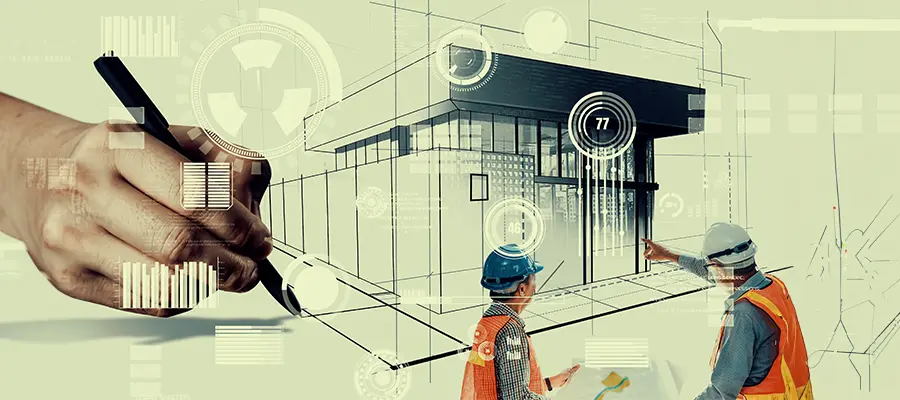Modern technology has changed how buildings are planned, developed, and built over and over again in architecture, engineering, and construction (AEC). Building Information Modeling (BIM) stands out as one of these innovations that has completely changed how the industry works and the standards used. Compared to standard 2D drawing methods, BIM provides a complete digital representation of a building’s physical and functional features. By combining geometric, dimensional, and contextual data into a single digital model, BIM helps everyone involved plan, create, build, and manage buildings more efficiently and accurately than ever.
In this blog, Brick & Bolt explains the details of building information modelling (BIM) in the construction industry, such as its background, main ideas, benefits, and how it will significantly change how buildings are planned, designed, and thought of in the future.
Understanding Building Information Modeling Services(BIM):
1. The Genesis of BIM:
The evolution of building documentation has changed a great deal since BIM came along, from drawings to digital models. Engineers and builders used blueprints and flat drawings in the past to show what they meant. However, BIM goes beyond these limits by making digital models that show the whole span of a building.
Early Days:
The first digitally generated house models were made in the 1970s, which is also when BIM first appeared. Since the 1990s, when the idea became popular, it has grown into a complete plan that includes building, managing buildings, and designing.
2. Core Principles of BIM
Physical and Functional Digital Characters:
The main goal of building information modelling (BIM) is to describe a structure’s physical and functional characteristics digitally. This includes details about the building’s shape and size and information about the materials used and how they will be used.
Cooperation and Coordination:
Building Information Modeling (BIM) makes it easier for people involved in the building process, such as contractors, architects, engineers, and site managers, to collaborate. By acting as a centralised hub, the model reduces errors and enhances coordination by guaranteeing that all parties work from the same data set.
Lifecycle Information Management:
BIM looks at the whole lifecycle of a building, not just its growth. Building Information Modeling, or BIM, is a complete source of information that can be used at any stage of a project, from planning and designing to building, maintaining, and taking down.
Benefits of BIM(Building Information Modeling)
1. Improved Visualisation and Design
Virtual Walkthroughs:
Building Information Modeling (BIM) lets you make detailed 3D models that show people what the planned building will look like in a way that is both interesting and accurate. Virtual walkthroughs are a new way for architects, clients, and project teams to see the design in a way that regular 2D models can’t match.
Iterative Design Process:
An iterative design method, BIM, makes it easier to do so. Model updates are quickly added to the project, so everyone on the team is always working with the most up-to-date information. This iterative method makes the design more adaptable and quick to change.
2. Enhanced Collaboration and Coordination
Centralised Datastore:
One of the best things about BIM is that it can be used as a central data store. Everyone can see and use the model, which allows them to share what they know and ensure that everyone agrees.
Real-time Collaboration:
BIM lets teams in different places work together remotely at the same time. Contractors, engineers, and architects can collaborate in ways that aren’t possible with traditional project management if they all use the same tool.
3. Clash Detection and Risk Mitigation
Preventing Conflicts:
By integrating clash detection features into the design process, building information modelling (BIM) enables project teams to spot possible conflicts or collisions before construction starts. Taking preventative measures makes mistakes less likely to occur, lowering the need for expensive redo during building.
Risk Mitigation:
BIM helps reduce risk by seeing possible problems early in the design process and resolving them. With educated decision-making, project teams may reduce risks and ensure a more seamless building process.
4. Cost Estimation and Resource Optimisation

Accurate Cost Estimation:
BIM facilitates precise cost estimation by offering comprehensive data on materials, quantities, and labour needs. The accuracy of the cost estimate improves financial planning and project budgeting.
Resource Optimisation:
By enabling project teams to plan and allocate resources more effectively, BIM helps to facilitate resource optimisation. BIM may make Construction processes more efficient and economical, which helps with everything from labour scheduling to material procurement.
Challenges in Implementing BIM:
1. Implementation Costs
Initial Investment:
Software, training, and technological infrastructure must be purchased to use BIM. It could be difficult for small and medium-sized businesses to make this initial investment.
ROI Over Time:
Although the initial outlay may seem high, the ROI (return on investment) throughout the project makes the outlay worthwhile. Organisations must, however, carefully evaluate their ability to bear these expenditures and, if necessary, arrange for a phased deployment.
2. Training and Skill Development
Converting to BIM Workflows:
Stakeholders moving from conventional construction workflows to BIM face a learning curve. Training programs are crucial to give architects, engineers, and contractors the skills to use BIM software efficiently.
Skill Shortages:
The industry may need more skilled professionals proficient in BIM methodologies. Addressing this challenge involves investing in education and training initiatives to build a workforce with BIM competencies.
3. Interoperability and Data Standards
Maintaining Compatibility:
Ensuring compatibility between various BIM software platforms might be challenging. Collaboration with multiple stakeholders utilising different software is standard in construction projects. It is essential to guarantee interoperability and seamless data transmission.
Collaboration and Data Standards:
Creating industry-wide data standards is a continuous process. Collaborative activities are required to develop standardised protocols that enable smooth information sharing and interoperability across various BIM platforms.
The Future of BIM in Construction
Building information modeling has changed the way buildings are planned, designed, and built, and it has become a competitive force in the construction industry. It looks like even bigger steps forward will be made in technology in the future, and BIM will be used in more areas of building.
1. Smart Cities and Infrastructure
BIM(Building Information Modeling) for Urban Planning:

BIM is growing to include whole cityscapes instead of just individual buildings. BIM is being used more and more in urban planning and the building of smart cities because digital models help people figure out how to combine ecology, transportation, and infrastructure.
Transportation and Infrastructure Projects:
BIM is used a lot in the planning and execution of transportation and infrastructure projects. It’s easier to organise the different parts of a project with BIM, which cuts down on downtime and improves the results of projects like highways and bridges.
2. Integration with IoT and AI
Internet of Things (IoT) and Real-time Data:
Putting BIM and IoT together can open up new possibilities. Real-time data from monitors built into buildings can improve BIM models and give us new information about how occupied buildings are, how much energy they use, and how efficient they are overall.
Artificial Intelligence for Predictive Analysis:
The use of artificial intelligence (AI) for predictive analysis makes BIM more useful by allowing for predicted analysis. AI algorithms can predict maintenance needs, make buildings more energy efficient, and improve their general operational performance by looking at data from BIM models.
3. Sustainable Construction Practices
BIM for Sustainable Design:
BIM is a big part of helping to make building methods more environmentally friendly. When designers and architects can model and analyse ecological factors to make building designs more energy efficient, construction projects have less of an effect on the environment.
Life Cycle Assessment:
From getting the materials to taking down the building, BIM’s life cycle assessment features let you see the environmental effect of a building as a whole. This information gives people who make decisions the power to make choices that support sustainable goals.
Building Information Modeling, which has changed the limits of traditional building methods, has brought about a new era of creativity, teamwork, and efficiency. We are moving toward a world that is more focused on BIM, which is causing a paradigm shift in the industry. This shift affects not only individual projects but also infrastructural development and urban planning as a whole.
BIM(Building Information Modeling) changes more than just technology in the construction business. It encourages teamwork, data-driven decisions, and building methods that are better for the environment. Even though there are problems to solve, BIM is still living up to its new promise. It offers the prospect of a time when building projects are carefully planned, optimised, and maintained over their whole lifecycle rather than just being built.

